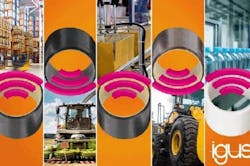Presented as a prototype in 2019, isense plain bearings allow machine designers to incorporate the bearings in machines for food industry, textile machines, forklifts, construction, and more. With the isense plain bearings, users receive a durable and lubrication-free solution that provides information about their wear. The information allows users to plan replacement and maintenance, reducing and eliminating downtime. The bearings are made with five iglide materials.
In the smart bearing, technology integrated into the bearing detects wear in advance and gives the user a signal when the wear limit is reached. Maintenance can be planned in advance, and unnecessary replacement and unplanned machine and system failures are avoided.
After many series of tests in the 3,800 square meter in-house test laboratory, igus has now developed the first isense standard range for its lubrication-free iglide plain bearings. The FDA-compliant material iglide A180, which is specifically designed for use in the food industry, the heavy-duty bearing iglide Q2E for use in construction machinery and agricultural engineering, the all-rounder material iglide G, the endurance runner iglide J, as well as iglide P210 as a specialist for pivoting and rolling applications are incorporated into the new bearings. igus offers all intelligent plain bearings in three dimensions each with an inner diameter of 20, 30, and 40 mm.
To connect the isense plain bearings, igus has four suitable cables with an oil-resistant and media-resistant PUR outer jacket, in four standard lengths of one to ten meters, in its portfolio. In addition, users have a choice between two connector types. Data captured by the sensors can be integrated by the machine and equipment operators into their systems in different ways. igus offers three readout units for this purpose: either the user can manually read out all plug-in points, or install a control unit with a red/green display on the machine which provides information about the condition of the plain bearings. Another possibility is the connection to icom.plus. For this purpose, a radio module sends the sensor data by wireless transmission to the communication module.
From here, the integration of data to the IoT, cloud system or to the customer network is possible on a wire-bound basis.





